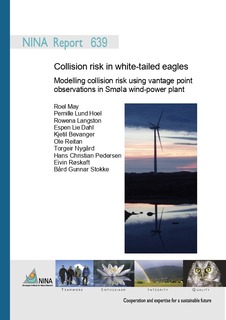Collision risk in white-tailed eagles. Modelling collision risk using vantage point observations in Smøla wind-power plant
May, Roelof Frans; Lund, Pernille Andersen; Langston, Rowena; Dahl, Espen Lie; Bevanger, Kjetil Modolv; Reitan, Ole; Nygård, Torgeir; Pedersen, Hans-Christian; Stokke, Bård Gunnar; Røskaft, Eivin
Research report

Åpne
Permanent lenke
http://hdl.handle.net/11250/2642580Utgivelsesdato
2010Metadata
Vis full innførselSamlinger
- NINA Rapport/NINA Report [2341]
- Publikasjoner fra CRIStin - NINA [2364]
Sammendrag
May, R., Hoel, P.L., Langston, R., Dahl, E.L., Bevanger, K., Reitan, O., Nygård, T., Pedersen,
H.C., Røskaft, E. & Stokke, B.G. 2010. Collision risk in white-tailed eagles. Modelling collision
risk using vantage point observations in Smøla wind-power plant. – NINA Report 639. 25 pp.
Large soaring birds of prey, such as the white-tailed eagle, are recognized to be perhaps the most vulnerable bird group regarding risk of collisions with turbines in wind-power plants. Their mortalities have called for methods capable of modelling collision risks in connection with the planning of new wind-power developments. The so-called “Band model” estimates collision risk based on the number of birds flying through the rotor swept zone and the probability of being hit by the passing rotor blades. In the calculations for the expected collision mortality a correction factor for avoidance behaviour is included. The overarching objective of this study was to use actual flight data and actual mortality to back-calculate the correction factor for white-tailed eagles. The Smøla wind-power plant consists of 68 turbines, over an area of approximately 18 km2. Since autumn 2006 number of collisions has been recorded on a weekly basis. The analyses were based on observational data from 12 vantage points collected in spring 2008; of which six vantage points were placed inside the wind-power plant. The results were verified using observational data from 10 vantage points within the wind-power plant from May 2009. In total, five white-tailed eagles have collided with wind turbines during the vantage point periods, between mid-March and the end of May 2008. In May 2009, only one white-tailed eagle was found dead. Given the vantage point observations data the correction factor (i.e. “avoidance rate”) used within the Band collision risk model for white-tailed eagles was 96.4 and 97.1% for 11 and 16 RPM, respectively. These values, however, assume that the wind turbines operated continuously with the respective RPMs. The correction factor adjusted for the actual wind speed distribution at Smøla WPA was 95.8%. We also derived uncertainty levels in the modelling, which resulted in a mean correction factor of 92.5% ± 9.7 SD. This may be due to the wind speed distribution during the period of interest, affecting both bird speed and flight activity. This would decrease the total period of interest; and lower the expected number of bird transits through the rotor swept zone. Although this modelling took into account variation in wind and bird speed, daylight and flight activity, there may exist possible sources of error, such as observer bias. These have been assessed. The correction factor was slightly lower using an independent vantage point data set from May 2009. The relatively low correction factor including uncertainty levels presented here, compared to that for most other raptor species, probably results from high levels of flight and breeding display activity, as demonstrated at the Smøla wind-power plant, where numerous collisions have occurred. Norway, Smøla wind-power plant White-tailed eagle, collision risk modelling, Norge, Smøla vindpark, havørn, kollisjonsrisikomodellering